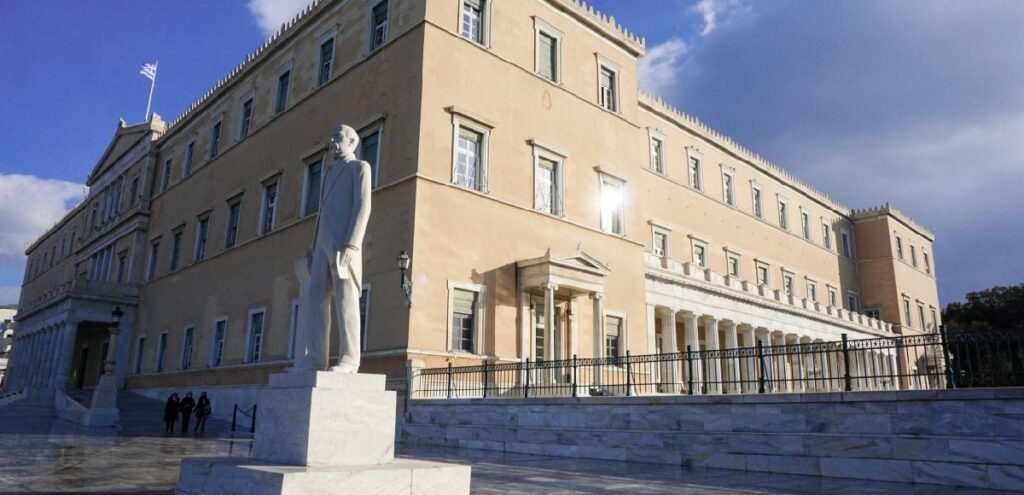Benefits worth €1.7 billion for 2026 including tax cuts and increases in wages, allowances, and extraordinary compensation are included in the new budget draft that was submitted to Parliament by Minister of National Economy and Finance Kyriakos Pierrakakis and Deputy Minister Thanos Petralia. On the economic front, it forecasts strong growth, high primary surplus, drastic debt reduction, and declining inflation and unemployment, but with high risk in achieving targets due to escalating geopolitical tensions and potential deviations from US-EU trade agreements.
In their letter to members of Parliament’s Standing Committee on Economic Affairs, Minister of National Economy and Finance Kyriakos Pierrakakis and Deputy Minister Thanos Petralia state: “The draft is submitted amid significant international uncertainty, both at geopolitical and fiscal levels. Geopolitical tensions in Ukraine and the Middle East, combined with increased protectionism and tariff impositions, as well as fiscal challenges facing major European economies, intensify uncertainty regarding global growth prospects.”
The draft includes the tax relief and income support package to be implemented next year while leaving a “window” for new benefits, both with the final draft vote in December, where the Prime Minister is expected to make surprise announcements supporting households against high rents, and in April 2026, when Eurostat data on 2025 growth and primary surplus will be confirmed. Initial estimates suggest potential interventions worth up to €1 billion without violating the basic Stability Pact rules with maximum spending ceilings.
Specifically, as the two ministers state:
”
regarding global growth prospects.
Despite the aforementioned increased uncertainty in the global economic environment, the Greek economy is projected to continue for the sixth consecutive year recording significantly higher real growth rates compared to the eurozone average. The growth rate is expected to reach 2.2% in 2025 and 2.4% in 2026. It should be noted that, according to the European Commission’s spring forecasts, the eurozone growth rate is estimated at 0.9% for 2025 and 1.4% for 2026, while according to recent European Central Bank forecasts in September 2025, eurozone growth is projected at 1.2% in 2025 and 1.0% in 2026. Nominal GDP is expected to increase from €249.6 billion in 2025 to €260.9 billion in 2026. Simultaneously, domestic inflation is expected to decline from 2.6% in 2025 to 2.2% in 2026.
Both tax reform and other interventions announced at the Thessaloniki International Fair play a significant role in accelerating the growth rate. Through structural income tax reform, focusing on young people, families with children, and the middle class, citizens’ income is directly enhanced. Additionally, rate reductions result in greater benefits for workers, pensioners, farmers, and freelancers with every future increase in their earnings. Within the demographic tax reform framework, additional measures with local characteristics and housing-related interventions are introduced, such as gradual ENFIA abolition for settlements with up to 1,500 residents, VAT reduction on border islands with up to 20,000 residents, reduced rental taxation combined with annual rent rebates, and reduced living standard assumptions for residences and other assets, exempting dependent children from minimum living expenses. Furthermore, pensioners’ income is enhanced through gradual elimination of pension increase offsets against personal differences, further pension increases based on GDP and inflation, and support for low-income pensioners and disabled individuals with €250 each November.
Investment growth rates are expected to increase from 4.5% in 2024 to 5.7% in 2025 and 10.2% in 2026, as alongside dynamic private investment performance, 2026 is expected to implement a significantly expanded public investment program with resources worth €16.7 billion, compared to €14.6 billion in 2025. This investment increase represents the second-largest increase in the eurozone for 2025 and the largest increase in both the eurozone and the 27-member European Union for 2026, further reducing the output gap. The average eurozone investment increase is estimated at 1.3% for 2025 and 2.2% for 2026, according to European Commission spring forecasts.
The unemployment rate, having declined to single digits already by 2025, is projected to improve further in 2026 by half a percentage point of the labor force, reaching 8.6% based on the Labor Force Survey, which corresponds to Greece’s lowest unemployment rate since 2008.
The primary result of the state budget is expected to reach 3.6% of GDP for 2025 and 2.8% in 2026, while the General Government’s total result will be 0.6% in 2025 and -0.1% in 2026. In this context, General Government debt as a percentage of GDP is expected to show the largest decline in the European Union for the sixth consecutive year and fall below 140%, with projections at 137.6%, the lowest level since 2010.
Despite the unstable global environment, Greece has become a reference point for stability and consistency in its economic policy. This recognition from European and international institutions is not self-evident. It results from collective effort, responsibility, and steady reform orientation. Maintaining fiscal balance, combined with continuing investments and structural changes, forms the basis for sustainable development and substantial improvement in all citizens’ living standards.”




